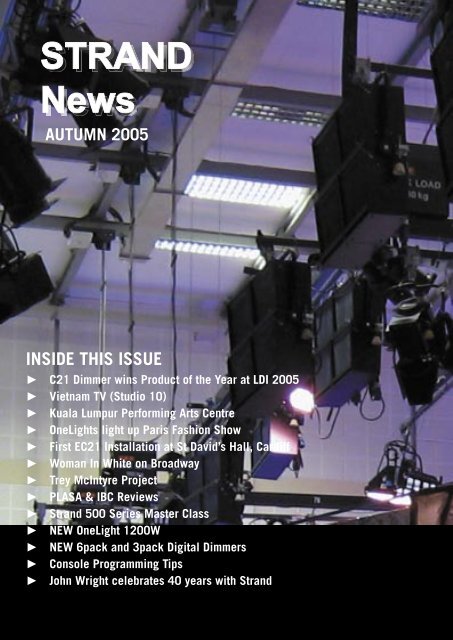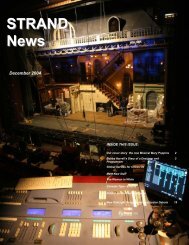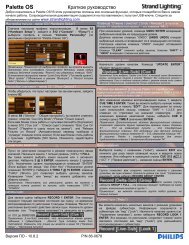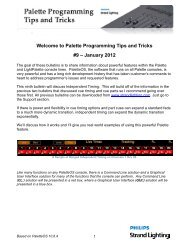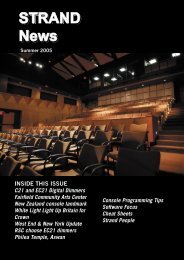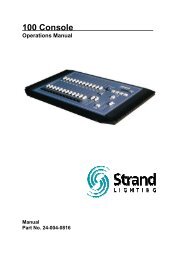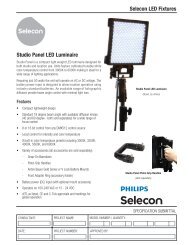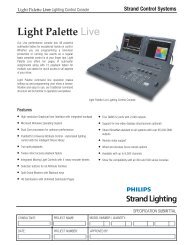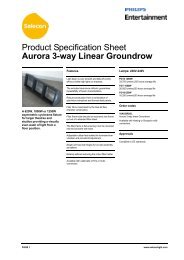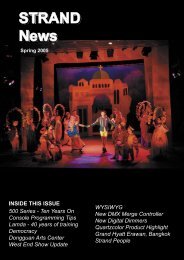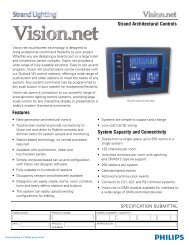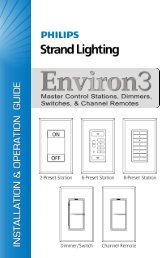STRAND News - Strand Lighting
STRAND News - Strand Lighting
STRAND News - Strand Lighting
You also want an ePaper? Increase the reach of your titles
YUMPU automatically turns print PDFs into web optimized ePapers that Google loves.
<strong>STRAND</strong><br />
<strong>News</strong><br />
AUTUMN 2005<br />
INSIDE THIS ISSUE<br />
► C21 Dimmer wins Product of the Year at LDI 2005<br />
► Vietnam TV (Studio 10)<br />
► Kuala Lumpur Performing Arts Centre<br />
► OneLights light up Paris Fashion Show<br />
► First EC21 Installation at St David’s Hall, Cardiff<br />
► Woman In White on Broadway<br />
► Trey McIntyre Project<br />
► PLASA & IBC Reviews<br />
► <strong>Strand</strong> 500 Series Master Class<br />
► NEW OneLight 1200W<br />
► NEW 6pack and 3pack Digital Dimmers<br />
► Console Programming Tips<br />
► John Wright celebrates 40 years with <strong>Strand</strong>
C21 Dimmer Rack wins <strong>Lighting</strong> Product of the Year Award<br />
at LDI 2005<br />
by Peter Rogers<br />
The C21 Dimmer range was recognized as the<br />
Product of the Year at LDI 2005 in Orlando recently.<br />
Tim Burnham, President of <strong>Strand</strong> <strong>Lighting</strong>, accepted<br />
the award at the LDI Awards ceremony “All of us at<br />
<strong>Strand</strong> are pleased to receive this recognition. I am<br />
very proud of the technical achievements of the entire<br />
C21 – EC21 design team led by Michael Lay and Steve<br />
Carlson.”, he said.<br />
C21 and EC21 dimmer racks are designed for<br />
global operation and provide a number of advances<br />
in technology. In addition to providing support for<br />
conventional SCR dimmers including Quad, Dual and<br />
single modules with ratings up to 12kW; sophisticated<br />
Sinewave dimmers are also available. Dual Sinewave<br />
modules may be freely mixed and matched with<br />
standard dimmers in the same rack for complete<br />
flexibility. No special wiring or separate racks are<br />
required for Sinewave dimming as we offer dual<br />
modules that are the same size as our standard dual<br />
dimmers. <strong>Strand</strong> TrueSine Sinewave dimmers offer<br />
a fully symmetrical Sinewave output for completely<br />
silent lamps and control for a wide range of loads. All<br />
systems are simple to use and set up through a Web<br />
Browser interface and an Ethernet input is standard<br />
on all racks.<br />
<strong>Strand</strong> has already demonstrated the full range of<br />
standard and TrueSine dimmers at trade shows<br />
throughout the world along with our powerful web<br />
based configuration and monitoring tools.<br />
Further product information is available on our<br />
website:<br />
www.strandlighting.com
Vietnam Television (VTV) Studio 10<br />
by Gary Yap<br />
Completed in July 2005 Studio 10 at<br />
Vietnam Television (VTV) in Hanoi,<br />
has been designed specifically for<br />
the popular “Who Wants To Be A<br />
Millionaire” game show. Designers<br />
also needed to consider the need<br />
for flexibility, as Studio 10 will<br />
also be required to accommodate<br />
any drama or game show in future<br />
projects.<br />
Design of the studio was completed<br />
in conjunction with VTV Technical<br />
Center For Program Production’s<br />
Mr Tran Van Long, Director and Mr<br />
Cao Van Liet, Deputy Director<br />
<strong>Strand</strong> <strong>Lighting</strong> were appointed for<br />
the design, supply, supervision,<br />
testing & commissioning of the<br />
project.<br />
<strong>Strand</strong>’s local distributor Tech<br />
Ventures System Pte Ltd worked<br />
closely with contractor Equipment<br />
and Materials of Information Import-<br />
Export Company (EMI Ltd) to ensure<br />
timely completion.<br />
Training will also be provided by<br />
<strong>Strand</strong> <strong>Lighting</strong>.<br />
Equipment List<br />
Rigging System<br />
1 x 6m diameter Prolyte CircularTruss<br />
lifted by 4 x 1000kg Prolyft Chain<br />
Hoists<br />
4 x IFF Combi Hoists with 10m<br />
triangular truss<br />
16 x IFF Combi Hoist with 7.3m<br />
<strong>Lighting</strong> Batten<br />
1 x Double Track IFF Type Rail<br />
Cyclorama Tracks with Off White<br />
Cyclorama Cloth and Surge Wool<br />
Black Curtain, with 2 x Side<br />
Tensioning Towers for Cyclorama<br />
Cloth<br />
Luminaires<br />
6 x Bambino 5kW P.O.<br />
16 x Bambino 2kW P.O.<br />
15 x Studio 1kW P.O.<br />
50 x 1kW PARCAN<br />
25 x 1kW Short Nose Parcan<br />
30 x Iris 4, 1.25kW, P.O.<br />
24 x Orion 4 Rigid<br />
6 x Orion 4 Hinged<br />
25 x SL15/32 Zoom Profile<br />
12 x Arturo 2 (1.25 / 2.50 kW)<br />
6 x Coda 500/1<br />
12 x Martin Mac 550<br />
12 x Martin Mac 600E<br />
Project Information<br />
Client<br />
Vietnam Television (VTV) , Hanoi / Vietnam<br />
Distributor: Tech Ventures System Pte Ltd<br />
Contractor: Equipment And Materials Of Information<br />
Import – Export Company (EMI. Co.)<br />
Accessories<br />
5 x Orion Input Cables<br />
6 x Eggcrates Narrow for Arturo 2<br />
6 x Eggcrates Wide for Arturo 2<br />
10 x Hercules Stands<br />
8 x Large Gaffer Grips<br />
2 x Operating Poles (1.4 - 4m &<br />
2.1 - 7.5m)<br />
25 x 19 degree SL Lens Tubes<br />
25 x 36 degree SL Lens Tubes<br />
1 lot of Socapex Extension Cables,<br />
16A Extension Cables<br />
<strong>Lighting</strong> Control and Dimmers<br />
1 x 520i Console 500 channel plus<br />
500 Attributes<br />
1 x A4 Digitising Tablet for moving<br />
lights<br />
1 x DMX Distribution System with<br />
Patch Panels and <strong>Strand</strong> 1-In<br />
6-Out DMX distribution amplifier<br />
220 Way CD80SV Dimmer System<br />
comprises:<br />
2 x CD80SV Large Racks<br />
1 x CD80SC Small Rack<br />
Single Processor for all racks<br />
22 x Dual 5.5kW Std Rise Time<br />
Dimmer Modules<br />
82 x Dual 3.3kW Std Rise Time<br />
Dimmer Modules<br />
12 x Dual 25A Relay Modules<br />
Additional information<br />
DMX data is distributed on Cat 5 cable.<br />
This will provide an easy upgrade path<br />
to a fully networked system.
The Kuala Lumpur Performing Arts Centre<br />
by Stephen Yim, Chia Kah Leong<br />
The Kuala Lumpur Performing<br />
Arts Centre (PentasSeni KL) is<br />
fast becoming the hub for the<br />
performing arts community,<br />
fostering creative excellence<br />
through the development and<br />
nurturing of performing arts<br />
culture.<br />
Main Theatre Pentas1<br />
A not-for-profit organisation, the<br />
Kuala Lumpur Performing Arts<br />
Centre is designed to meet the<br />
needs of an ever more demanding<br />
and diverse performing arts scene<br />
in Malaysia. Located in the midst<br />
of parkland and lakes in Sentul Park,<br />
the arts centre is located only 10<br />
minutes from a railway station and<br />
20 minutes by car from the city<br />
centre.<br />
The complex comprises a 504 seat<br />
proscenium theatre, a 200 seat<br />
experimental black box, the IndiCine<br />
for independent film makers; an<br />
onsite set construction workshop,<br />
an academy with 10 studios, and<br />
much more.<br />
KLPac collaborates with companies<br />
from around the world on a regular<br />
basis. They also work closely with<br />
organisations such as the British<br />
Council, The Japan Foundation<br />
and the cultural sections of many<br />
foreign missions to bring overseas<br />
productions to the Malaysian stage.<br />
The founding partners in the<br />
complex are Yayasan Budi Penyayang<br />
Malaysia, YTL Corporation and The<br />
Actors Studio.<br />
Penyayang’s role in the newly<br />
formed KL Performing Arts Centre/<br />
PentasSeni KL is in keeping with<br />
their objective of assisting the<br />
promotion of cultural heritage and<br />
the arts. Datin Paduka Seri Endon<br />
Main Theatre Barrel View<br />
Main Theatre Grid Floor<br />
Mahmood, who heads the charitable<br />
Foundation, is the Patron of KLPac.<br />
YTL Corporation is widely recognised<br />
as a supporter of the arts with their<br />
sponsorship of the Penang-YTL Arts<br />
Festival, the annual YTL Concert of<br />
Celebration and past sponsorship<br />
of the Kuala Lumpur Symphony<br />
Orchestra. KLPac is a continuation<br />
of this commitment to share the gift<br />
of the arts with the community and<br />
to promote cultural development in<br />
Malaysia.<br />
Experimental Theatre Grid View<br />
Experimental Theatre Dimmer Room<br />
The Actors<br />
Studio is one<br />
of Malaysia’s<br />
l e a d i n g<br />
t h e a t r e<br />
companies.<br />
F o u n d e r s<br />
Joe Hasham<br />
and Faridah<br />
M e r i c a n ,<br />
in their<br />
r e s p e c t i v e<br />
roles as Artistic Director and<br />
Executive Producer of KLPac, will<br />
be instrumental in managing the<br />
artistic programme and helping to<br />
realise KLPac’s vision of establishing<br />
the Centre as the performing arts<br />
heart of the community, making<br />
quality live theatre accessible to all<br />
Malaysians.<br />
Equipment List<br />
www.klpac.com<br />
Control & Dimming Systems<br />
Main Theatre<br />
4 x CD80SV (192 channels) with SN110/<br />
POE<br />
Controlled by a 600 channel 520i control<br />
desk<br />
Network & Accessories:<br />
R140 Wired Remote Focus Unit,<br />
xConnect USB Designer Remote, SWC<br />
System Wide Control, 6 x SN110/POE<br />
Ethernet Nodes<br />
Experimental Theatre<br />
1 x CD80SV (48 channels)<br />
Controlled by a 125 channel GSX desk<br />
Luminaires<br />
48 x Alto F Fresnel Spotlight<br />
26 x Alto PC PC Spotlight<br />
24 x Cantata F Fresnel Spotlight<br />
18 x Cantata PC PC Spotlight<br />
40 x SL19 Coolbeam Profile Spotlight<br />
40 x SL26 Coolbeam Profile Spotlight<br />
40 x SL36 Coolbeam Profile Spotlight<br />
30 x SL50 Coolbeam Profile Spotlight<br />
30 x SL15/32 Coolbeam Profile Spotlight<br />
30 x SL23/50 Coolbeam Profile Spotlight<br />
20 x Quartet F Fresnel Spotlight
Collection d’hiver mise en lumière par le OneLight PAR 575W<br />
Ecole des beaux Arts, Paris. 25 Juillet 2005<br />
Lumière et Son Paris a inauguré l’utilisation du<br />
OneLight PAR 575W à l’occasion d’un defilé de<br />
moded’une marque de haute couture. “C’était<br />
en fait l’un des derniers défilés de la saison,nous<br />
venions tout juste de recevoir les OneLight et nous<br />
avons tenu à les utiliser avant la prochaine saison<br />
qui débutera en Octobre”, indique Monsieur Pierre<br />
Heyligen, Directeur général de Lumière et Son<br />
Paris. L’utilisation de projecteurs en lumière du jour<br />
est unetendance actuelle des défilés, elle permet<br />
de recréer les conditions photographiques d’un<br />
studio photo. Les OneLight PAR ou Fresnel 575W<br />
sont tout particulièment adaptés à cette utilisation,<br />
en effet leurmise en place est aussi simple que<br />
pour des projecteurs tungstènes: plus de montée<br />
de lampe, plus de ballast à cacher !<br />
De plus, le pilotage par DMX rend l’ensemble<br />
dusystème très facile à gérer depuis le pupitre.<br />
20 x OneLight PAR 575W on the set<br />
Winter Fashion show put in light<br />
with OneLight PAR 575W<br />
Ecole des beaux Arts, Paris. 25 July 2005<br />
Rigging the OneLight: a piece of cake<br />
Lumière et Son Paris has pioneered the use of the<br />
OneLight PAR 575W during a Paris Fashion show held<br />
at the Ecole des beaux Arts in Paris.<br />
“It was one of the last fashion shows of the season,<br />
and we’d just received the OneLights. We wanted<br />
to test them live before the next season started in<br />
October”, indicates Mr Pierre Heyligen, Managing<br />
Director of Lumière et Son Paris.<br />
The use of daylight luminaires is a new trend in fashion<br />
shows, recreating the conditions of a photographic<br />
studio. The OneLight PAR and Fresnel are particularly<br />
suitable in this application. Installation is as simple<br />
as tungsten luminaires: No head to ballast cable, nor<br />
ballast to hide!<br />
In addition, the DMX function allows easy control of<br />
the whole system by the control desk.
St David’s Hall, Cardiff - turns on first EC21 installation in Europe<br />
by Bethan Dickson<br />
August 2005 saw the commissioning<br />
of the first EC21 installation in<br />
Europe. <strong>Strand</strong> distributor, Northern<br />
Light, completed the installation as<br />
part of ongoing improvements to<br />
the venue, which is situated in the<br />
very heart of Cardiff, capital city of<br />
Wales. St David’s Hall is the National<br />
Concert Hall and Conference Centre<br />
of the principality.<br />
St. David’s Hall has a main stage<br />
platform with capacity for a full<br />
international orchestra of up to<br />
120 musicians, with the flexibility<br />
of ten lifts within the stage area<br />
to accommodate any performace<br />
requirement. Today the venue<br />
presents a multitude of live<br />
entertainment, including pop, rock,<br />
jazz, comedy, children’s shows,<br />
lunchtime concerts, classical music,<br />
light entertainment and dance.<br />
The new EC21 dimmers replace the<br />
long-serving <strong>Strand</strong> MCM dimmers<br />
which were installed during a<br />
previous redevelopment of the site<br />
in 1982.<br />
David Vandepeear, Project Manager<br />
for Northern Light, led the installation<br />
team with <strong>Strand</strong> commissioning<br />
engineers also attending in support<br />
of the new product debut.<br />
EC21 dimmers proved easy to install<br />
and were quickly up and running.<br />
St David’s Hall also features <strong>Strand</strong><br />
530i control desks with 510i backup.<br />
A new fibreoptic connection to<br />
the dimmer room now links the<br />
consoles, nodes and dimmers<br />
using <strong>Strand</strong> ShowNet making a<br />
comprehensive <strong>Strand</strong> network<br />
installation.<br />
Equipment List<br />
2 x EC21 digital dimmer racks<br />
with 166 channels<br />
comprising:<br />
40 x Dual 3kw modules<br />
37 x Dual 5kW modules<br />
12 x Single 10kW modules<br />
www.stdavidshallcardiff.co.uk<br />
www.northernlight.co.uk<br />
EC21 Now ex-stock<br />
Delivery of first EC21 racks and modules. Kirkcaldy, Scotland<br />
Mike Stanners, Customer Service Manager (right), takes<br />
possession of his first EC21 racks.
Woman in White: From the West End to Broadway<br />
By Bobby Harrell<br />
“Woman in White”, the popular West End musical, is<br />
making the trek across the pond from The Palace<br />
Theatre in London to The Marquis Theatre in New<br />
York this fall. The show goes into previews on<br />
October 28 th with an opening<br />
night on November 17 th .<br />
I asked David Howe, Associate<br />
<strong>Lighting</strong> Designer for Paul Pyant,<br />
to tell me a little about the<br />
process for selecting control for<br />
this show.<br />
“We chose the <strong>Strand</strong> 500 Series<br />
console for ‘Woman in White’ for a<br />
variety of reasons:<br />
<strong>Strand</strong> consoles are well used in the<br />
UK especially as many houses<br />
(theatres) own their own consoles. For the West End we<br />
augmented the house desk with an upgrade of channel<br />
software to their existing 520i console and 510 backup.<br />
For the production period we then rented a larger 550<br />
console as a programming surface which acted as a<br />
slave console to the house desk, allowing our<br />
Programmer, Vic Smerdon, to use the extra sub masters<br />
and faders for the plotting of the show.<br />
For the New York production it<br />
made sense to transfer the show<br />
and console spec directly from<br />
London, we used a 550i console<br />
and 520i backup console and<br />
imported the existing show file as<br />
a starting point for programming.<br />
Due to the network capabilities of<br />
the console also we were able to<br />
provide the amount of video output<br />
for the LD and team both via<br />
Video Nodes and also the<br />
xConnect software to our PC’s at the tech table to save<br />
on the multiple number of Video Monitors.<br />
From a designers point of view the console gives us a<br />
very stable control platform from which to light the show,<br />
the flexibility of the software enables us as designers to<br />
work in either tracking or Genius mode dependant on the<br />
show requirements and our approach. In New York and<br />
London, our programmer, Vic Smerdon, has worked hard<br />
in her set-up of the console and software to allow us to<br />
quickly respond to what is happening on stage,<br />
attributes, color and Moving Light templates are all laid<br />
out on the sub masters for ease of access. In the UK the<br />
relationship between a designer and the programmer is<br />
integral to the lighting of the show, we rely on the<br />
operator to undertake a great deal of the ‘behind the<br />
scenes’ programming and the 500 series software and<br />
consoles give us and the programmer this high degree<br />
of control.”<br />
Vic Smerdon is programming in New York on a<br />
<strong>Strand</strong> 550i with a 520i for backup. She is<br />
controlling 13 VL3000Q Spots, 14 Clay Paky Halo<br />
Alpha Washes, 18 ETC Revolutions, 10 City<br />
Theatrical Auto Yokes, 6 <strong>Strand</strong> Pirouettes with<br />
Rainbow Scrollers, 14 <strong>Strand</strong> Tocatta Effects<br />
Projectors with White Light VSFX Discs, 1 PANI<br />
2.5k HMI projector, over 100 Wybron scrollers,<br />
over 200 conventionals and 15 Look Solutions<br />
Unique Hazers and Viper NTs.<br />
All the lighting equipment is provided by Hudson<br />
Sound & <strong>Lighting</strong>.<br />
Here are her comments on the desk:<br />
“As someone who is very familiar using the 500 series<br />
as a theatrical lighting console, for a show like this I<br />
feel that it is absolutely the best for the job. It enables<br />
us to control both the generic and automated units with<br />
ease and fluidity, and gives us a greater control of cue<br />
structures than is perhaps available<br />
with some of the more common<br />
'moving light' desks.<br />
Because each cue sequence is<br />
closely tied in with complex<br />
projection and automation cues, we<br />
quickly discovered during the<br />
original process in London that if we<br />
could create a sequence of cues that<br />
would run happily along with the<br />
various scene changes, it would make life easier for<br />
the DSM (Stage Manager) and board operator alike.<br />
Thus for every scene change there is generally a linked<br />
sequence of cues and part cues, which means that in a<br />
fairly busy show there are little more than 50 called<br />
cues for each act, but a total of at least 400 cue parts<br />
for the entire show. The ease with which we did this is,<br />
I think, down to the <strong>Strand</strong>'s functionality and versatility<br />
in building such sequences.<br />
Furthermore, from my point of view, the presence of<br />
preset focus groups made transferring the show much<br />
easier than I expected - coupled of course with<br />
FocusTrack it became a very straightforward process
for focusing all the moving lights - even without focus<br />
notes we would have been able to figure out how it<br />
should have looked with preset focus groups for<br />
positions, zoom, gobos etc.<br />
From a programming point of view, the <strong>Strand</strong> is one of<br />
the most versatile systems I have ever come across.<br />
Things like the user-edited ATC pages mean that you<br />
can set up the console exactly how you might like, and<br />
with the ability to double or even triple macro buttons by<br />
using the submaster bump buttons, almost everything is<br />
accessible at the touch of a button. Hence we're able to<br />
keep up with changes from automation and video very<br />
easily, and so we all look good!”<br />
Vic mentions FocusTrack.<br />
Go to http://focustrack.co.uk/ for details.<br />
One of the things that David mentions is the<br />
xConnect software that <strong>Strand</strong> has developed to<br />
expand the way that designers think about video for<br />
the tech table. With xConnect, the design staff can<br />
choose their own screens in their<br />
own format independent of the<br />
programmer’s choices on the<br />
console itself.<br />
in Login mode. In Login mode, Jared is logged in<br />
as a console! If this were a non-union situation,<br />
Jared could actually have control of the lights. He<br />
could bring up channels, dimmers, run<br />
cues…anything a console can do. But since this<br />
is a Broadway show, I have restricted the<br />
functionality to conform to Local 1 limits. That’s to<br />
say, he can’t actually control any lights, but he can<br />
control how his screens are configured. With<br />
Victoria programming the show in Genius mode,<br />
she likes to use the Galaxy screens which layout<br />
the channels in a vertical format. Since this is a<br />
screen format that most American designers are<br />
not used to, Jared has configured his screens for<br />
LightPalette mode. These limits are actually a<br />
good thing. This way, Jared can’t accidentally<br />
press the wrong key and affect the programming<br />
of the show. He can look at any screen he wants,<br />
(live, preview, groups, subs, fx, or macros) or page<br />
to a different channel screen whenever he wants<br />
and not affect the programming…ever!<br />
Here is what Jared Sayeg, the US<br />
Assistant <strong>Lighting</strong> Designer, had to<br />
say about xConnect:<br />
“X-Connect became an invaluable aid<br />
during production by providing a unique<br />
way of viewing information through<br />
customizing screen displays and user<br />
settings. This gave me the information I<br />
needed to be viewing without<br />
interrupting the command line of the<br />
programmer or interfering node<br />
display's on the network. For year's<br />
designers, assistants, and technicians<br />
have become used to viewing the<br />
typical 2-screen node display, only<br />
changing at the keystroke of who<br />
is operating the console. Now with<br />
xConnect, not only have you gained flexibility in<br />
viewing the console's information, you have completely<br />
bypassed taking the programmer away from their work<br />
by asking to ‘PAGE’...a dream finally realized!”<br />
Jared has setup his laptop with a four screen view<br />
using multiple logins. The top two screens are in<br />
Monitor mode. This means that xConnect is simply<br />
monitoring the console screens. (This is what we<br />
are all familiar with using an SN100 video node.)<br />
The unique thing is the bottom two screens that are<br />
Assistant <strong>Lighting</strong> Designer Jared Sayeg’s xConnect<br />
screens at the production table for Woman in White<br />
xConnect can be utilized with any current 500<br />
series installation and any 300 series console that<br />
has a network card.<br />
Additional production staff includes:<br />
Vivien Leone - US Associate <strong>Lighting</strong> Designer<br />
John Lawson - Production Electrician
Trey McIntyre Project 2005 Inaugural Season<br />
by Nic Phillips<br />
When planning TMP’s first tour I<br />
decided it was necessary to have<br />
the company tour with a lighting<br />
console. The company was touring,<br />
for the most part, to festival venues<br />
where there would be significant<br />
recreation work to be done as no<br />
two plots were the same.<br />
Without question the <strong>Strand</strong> 500<br />
series was the only choice for me<br />
with its unique features to translate<br />
shows within the console. The rep<br />
consisted of three ballets, one<br />
a premiere, and the other two<br />
from two existing with cues from<br />
different sources. One of which<br />
was a Trackmaster 2 (by Status<br />
Software) file, and the other an<br />
ETC Expression file. Using <strong>Strand</strong>’s<br />
Showport program, I was able to<br />
convert both to a <strong>Strand</strong> Show File,<br />
and then use the console to translate<br />
the old channels to the new.<br />
This saved an immense amount<br />
of time since the console already<br />
had cues in the console ready to<br />
go for the first tech. I could then<br />
quickly track changes needed to<br />
make the pieces look as they did<br />
when originally set. Features like<br />
trackback, spreadsheet style editing<br />
in the live command line, the ability<br />
to renumber channels globally,<br />
selective loading of show data, and<br />
all the features of the Tracker Preset<br />
application are what make the<br />
<strong>Strand</strong> system stand out. To me it<br />
equates confidence in not having to<br />
be concerned with how the console<br />
is going to get done what I need<br />
done. <strong>Strand</strong>’s software actually<br />
helps the designer!<br />
This would have all been so easy<br />
if I could have actually sent a 500<br />
Series desk with the company. On<br />
the other hand, this would not be<br />
so interesting if there was not some<br />
sort of limitation, and in this case the<br />
console needed to travel as checked<br />
luggage on a commercial flight. This<br />
requirement put the 500 Series form<br />
factor out of the question, so the<br />
compact and arrange-able panels<br />
of the 300 Series fit the bill exactly.<br />
To make the 300 Series tour able<br />
this way I turned to <strong>Strand</strong> dealer<br />
Parlites. Cary Levitt, Walt Dowling,<br />
and their staff worked with <strong>Strand</strong><br />
to devise a system that fit the travel<br />
and design requirements.<br />
Our “custom” solution consisted of<br />
a 300 Series programming panel, a<br />
fader panel, a 300 Series processor,<br />
two 15” LCD displays, a Linksys WiFi<br />
router, a UPS, and a SN110 node. All<br />
of this was packaged into two hard<br />
cases that fit airline checked luggage<br />
regulations, so it worked quite well.<br />
The console was packaged with<br />
400 intensity channels and 200<br />
attribute channels, WiFi, and all of<br />
the applications commensurate<br />
with a 500 Series package.<br />
Networking and the SN110 node<br />
proved to be invaluable.<br />
Being able to put two<br />
universes of DMX away<br />
from the console let<br />
me quickly place the<br />
faceplate in the house<br />
for tech, and then to<br />
the booth or backstage<br />
for the performances.<br />
XConnect running on my<br />
Powerbook then allowed<br />
me a remote console and<br />
monitors anywhere in the<br />
theater, and of course,<br />
wireless remote via the iPaq, need<br />
I say more?<br />
Thank you greatly to Parlites and<br />
<strong>Strand</strong> <strong>Lighting</strong> for their assistance<br />
in making Trey McIntyre Project’s<br />
inaugural such a success!<br />
“Without question the<br />
<strong>Strand</strong> was the only<br />
choice for me ”
PLASA & IBC<br />
PLASA (September 11-14)<br />
Our new digital dimming products<br />
took centrestage on the <strong>Strand</strong><br />
booth this year.<br />
Appearing at PLASA for the first<br />
time was the EC21 series dimmer<br />
rack. The new racks support a wide<br />
range of dimmers including Quad<br />
2.5kW, Dual 3kW and 5kW and<br />
Single 10kW thyristor dimmers.<br />
There are also dual 3kW and<br />
5kW Snewave modules and<br />
each features a fully symmetrical<br />
Sinewave output with less than<br />
EC21 digital dimmer rack<br />
1% harmonic distortion. Sinewave<br />
dimmers may be mised and<br />
matched with standard dimmers in the same rack for<br />
complete flexibility.<br />
Also shown for the first time was the new 6pack digital<br />
dimmer, featuring 6 x 10amp dimmers in a compact<br />
rack or wall mounting package.<br />
Our thanks to Sparks Theatrical Hire for their work<br />
installing lighting for our stand.<br />
6pack digital dimmers<br />
IBC (September 9-13)<br />
IBC 2005 proved to be very busy and we were able to<br />
showcase the latest additions to the OneLight PAR and<br />
Fresnels range.<br />
The new 1200W MSR daylight luminaires were introduced<br />
at IBC.<br />
Like the 575W OneLight units introduced last year, the<br />
new OneLight 1200W features a quiet fully integrated<br />
high frequency electronic ballast designed with<br />
ClearArc technology for maximum useful lamp life and<br />
performance.<br />
OneLight 1200W PAR & Fresnel<br />
These new OneLights also<br />
support an optional DMX<br />
control module.<br />
Our thanks to Barndoor<br />
who assisted us in the<br />
design and build of our<br />
stand again this year.
<strong>Strand</strong> 500 Series Master Classes<br />
By Bobby Harrell<br />
Many new features have been added to the <strong>Strand</strong><br />
500 series consoles over the course of its 10 year<br />
development. So much so, in fact, that official<br />
training has been requested by operators that have<br />
been using the desks for years! Compared to the<br />
functionality of the consoles from the late 1990s, it’s<br />
like having a brand new desk for some users. Many<br />
of the features that have been recently enabled<br />
allow for much smarter use of conventional fixtures<br />
and so many more of the features increase<br />
functionality of automated luminaire programming.<br />
Philadelphia Local 8 Training<br />
I have developed a<br />
training course that I<br />
teach for user groups<br />
all over North<br />
America. This<br />
summer, I was<br />
brought in by IATSE’s<br />
Local 8 in<br />
Philadelphia for a 3<br />
day masterclass at<br />
the Kimmel Center.<br />
This was taught to<br />
users of all levels that<br />
work with the 500<br />
series consoles all<br />
over the city.<br />
IATSE Local 8 members<br />
discussing moving light programming.<br />
Each class starts with conventional lighting<br />
programming and then moves into automated fixture<br />
programming. We had full use of the Kimmel<br />
Center lighting rig with 5 <strong>Strand</strong> 500 series consoles<br />
all linked together on the same network running<br />
conventional lights, scrollers and movers.<br />
Here is what David W. Cecil, a participant, had to<br />
say about the class…<br />
“Although I had been operating <strong>Strand</strong> <strong>Lighting</strong> Consoles<br />
for several years I found Bobby Harrell's instruction for<br />
the <strong>Strand</strong> 520i and 550i to be invaluable. In his course,<br />
Mr. Harrell outlines an efficient approach for the<br />
operation of intelligent lighting fixtures.<br />
His demonstrates how to edit fixture libraries, attribute<br />
filters and profiles. His methods for organizing<br />
groups and macros proved to be most illuminating. His<br />
comprehensive methodology enables you to<br />
successfully integrate moving and conventional fixtures<br />
on a single console and still program complex lighting<br />
presentations. It is, without a doubt, one of the best<br />
professional courses I have ever attended.”<br />
Many thanks to Michael Sweeney, Master<br />
Electrician of the Kimmel Center and Jim<br />
Utterback from Local 22 for their help.<br />
Canada Training in Edmonton & Calgary<br />
In September, I traveled to Edmonton and Calgary<br />
to teach master classes for Canadian users.<br />
Always starting with conventional programming<br />
then moving into automated fixtures, each class is<br />
customized to the students’ level of experience.<br />
Each Canadian class lasted one day but I have<br />
taught extensive 5 day classes. That gets very<br />
hands on and finishes with a single day design<br />
and cueing project for the students.<br />
The Masterclass in Edmonton. 5 – 520i consoles,<br />
4 - Technobeams with xConnect and WYSIWYG.<br />
Thanks to Rob Montgomery and Richard Goode<br />
for all their help.<br />
If you have a need for training in your area, don’t<br />
hesitate to contact your local union. Many have<br />
education programs for funding of training. For<br />
non-union training of designers, programmers,<br />
electricians and students…contact me directly or<br />
sign up for my classes at future trade shows!
NEW PRODUCTS ∙ NEW PRODUCTS ∙ NEW PRODUCTS ∙ NEW PRODUCTS<br />
NEW OneLight PAR 1200W<br />
by Alain Wisniewski, Quartzcolor Product & Sales Director<br />
The OneLight family welcomes the 1200W Fresnel and PAR.<br />
The OneLight concept of integrated ballast technology makes<br />
the use of daylight luminaires very easy - no more hassle with<br />
ballast to head cables, and no separate ballast.<br />
This technological breakthrough uses a sinewave ballast<br />
designed by our partner Power Gems Ltd. This ballast is flicker<br />
free, through the innovative use of a high frequency sinewave<br />
(300 kHz ) to operate the lamp from the integrated ballast.<br />
OneLight units provide totally silent operation; crucial in<br />
sensitive applications like movies, interviews, studio work.<br />
OneLight 1200W also has a weight advantage. At 16kg, it is<br />
only slightly heavier than many of the “head only” alternatives<br />
available on the market!<br />
One Philips MSR 1200W HR lamp is provided with the unit.<br />
As with others models in the OneLight family, the 1200W very<br />
cost effective with savings of up to 25% for similar separate<br />
head, ballast, and lamps systems.<br />
Successfully introduced at both PLASA, London and IBC,<br />
Amsterdam, the first units will be available early next year.<br />
NEW Philips Lamp: MSR 250W HR<br />
by Alain Wisniewski, Quartzcolor Product & Sales Director<br />
Philips has announced the launch of a new daylight lamp MSR 250 HR. This development enables the immediate<br />
extension of our OneLight family with the 250W Fresnel OneLight. This product is already listed in the <strong>Strand</strong><br />
Product Guide (originally developed with the CST lamp)<br />
a<br />
b<br />
Figure a : existing 250W CST (3200 ºK)<br />
Figure b: NEW 250 MSR HR (6000 ºK)<br />
OneLight Fresnel 250W CST<br />
and now also MSR 250W HR
NEW PRODUCTS ∙ NEW PRODUCTS ∙ NEW PRODUCTS ∙ NEW PRODUCTS<br />
6pack 6 x 10A Digital Dimmer<br />
3pack 3 x 25A Digital Dimmer<br />
Ideal for use in small to medium size<br />
installations, rental applications and for<br />
portable use.<br />
The 6pack and 3pack are a family of<br />
cost effective, fl exible digital dimmer<br />
packs with a wide range of features<br />
and socket options.<br />
The 6pack features 110µs chokes<br />
(3pack 140µs).<br />
The simple control interface enables<br />
users to set DMX address, minimum<br />
/maximum levels and dimmer curves<br />
channel by channel.<br />
Three dimmer curves including linear,<br />
non-dim and square may be assigned<br />
to each dimmer<br />
Each channel is protected by a<br />
magnetic circuit breaker and rated at 10<br />
Amps (2.3kW) for 6pack; 25A (5kW) for<br />
3pack. All racks are convection cooled<br />
for quiet operation.<br />
The sliding electronics tray gives easy<br />
service access even after installation.<br />
Ordering Information<br />
Cat No Description<br />
75301 6pack 6x10A Hardwired<br />
75302 6pack 6x10A Dual 15A<br />
75303 6pack 6x10A Dual Schuko<br />
75304 6pack 6x10A Dual CEE17<br />
75305 6pack 6x10A Dual French<br />
Special Order 6pack 6x10A Dual Swiss<br />
75300 3pack 3x25A CEE17<br />
Features<br />
• MCB (SPN) protection for each channel<br />
• Wide range of socket options including<br />
Dual UK 15A, Schuko, French, CEE17,<br />
CEE17 (32A connector, 5kW load) and<br />
hardwired<br />
• Suitable for portable, rack-mount and<br />
wall-mount operation<br />
(wall brackets included)<br />
• Single or three phase operation<br />
• Fully digital control electronics<br />
• DMX In/Out<br />
• Simple Set up using front panel keypad<br />
and LED display<br />
• DMX fail hold function<br />
• DMX termination switch<br />
• Selectable Minimum Level for each<br />
dimmer<br />
• Local on/off test buttons<br />
• DMX addressing with individual<br />
patching for all dimmers<br />
• Simple slide-out service access<br />
• Fan free convection cooling for quiet<br />
operation<br />
6pack Dual Schuko<br />
6pack Dual 15A<br />
6pack Dual 16A<br />
3pack 3 x CEE17
Console Programming Tips, Autumn 2005<br />
by Rob Halliday<br />
Moving Information Around The<br />
Console<br />
In the old days, it seemed so much<br />
easier to use lighting consoles. You<br />
brought up a bunch of channels to<br />
make a pretty look on stage, then<br />
you pressed the ‘Record’ key to<br />
commit that look to memory. Later,<br />
to get that look back you played the<br />
cue; sometimes you made some<br />
adjustments then recorded again.<br />
The arrival of moving lights,<br />
scrollers and all of the other current<br />
Getting Lights To Look As They Do In<br />
Other Cues<br />
If you want the look of cue 1 back<br />
on stage, that’s easy: run cue<br />
1 either using [CUE][1][GOx1]<br />
or [CUE][1][CUTx1] or<br />
[GOTO][CUE][1][*] according to<br />
taste (though note that there is a<br />
subtle difference between the use<br />
of GO/CUT and GOTO: when the<br />
cue ends up on stage using the first<br />
two the channel colours on the live<br />
screen - green for channels going<br />
down, purple for channels going<br />
up - will be relative to whatever<br />
was last live; when using GOTO<br />
they will be relative to the previous<br />
cue in the cue list regardless of<br />
what was on stage beforehand; a<br />
subtle difference but sometimes<br />
an important one, particularly when<br />
jumping around a show out of<br />
order).<br />
But what if you only want to pull<br />
back part of the look - perhaps only<br />
what channel 1, a moving light, was<br />
doing in cue 50? Easy:<br />
[1] [@] [CUE] [50] [*]<br />
Channel 1 will now be doing ‘live’<br />
exactly what it was doing in cue<br />
50. But perhaps we only wanted to<br />
get channel 1 pointing to the right<br />
direction in the right colour rather<br />
than have it come on:<br />
[1] [@] [CUE] [50] {ATTS ONLY} [*]<br />
ATTS ONLY means ‘pull back the<br />
attributes only, ignore the recorded<br />
‘must haves’ of lighting seem to<br />
have made things harder - but only<br />
because with them, you want to do<br />
more complex things! If you wanted<br />
to put channel 1 to the level it was<br />
at in cue 1, you used to just look up<br />
that level then type ‘1@5’, perhaps<br />
followed by a press of the [*] key if<br />
working in command line mode. But<br />
if 1 is a moving light and you want to<br />
put it back to looking as it did in cue<br />
1, that’s harder.<br />
Fortunately <strong>Strand</strong> 300- and 500-<br />
series consoles offer lots of ways to<br />
intensity’. Equally, we could have<br />
wanted just to the set the light to<br />
the level it had in cue 50 but leaving<br />
it pointing where it was currently<br />
pointing - intensity only rather than<br />
attributes only:<br />
[1] [@] [CUE] [50] {INTS ONLY} [*]<br />
INTS ONLY and ATTS ONLY appear<br />
as softkeys on the left-hand set of<br />
softkeys on 530i and 550i consoles;<br />
on 520i and 300 consoles you may<br />
have to press the [REC MODE]<br />
key to get them to appear on your<br />
softkey LCD display; on an off-line<br />
editor or xConnect, the ‘J’ key<br />
corresponds to REC MODE.<br />
It’s possible that we might want to<br />
refine things further - to leave the<br />
light pointing to where it’s pointing<br />
now, but to set it to the colour it<br />
was in in cue 50:<br />
[1] [@] [CUE] [50] [@ATT] {colour}<br />
[*]<br />
(where @ATT is called ATTRIB on<br />
300-series consoles)<br />
This uses the consoles ‘function<br />
filters’ to just pull back the attributes<br />
defined as colour attributes . You can<br />
combine multiple function filters, so<br />
if you wanted to pull back position<br />
and colour you could have said [@A<br />
TT]{position}{colour}. You can define<br />
which attributes are controlled by<br />
which function filter (and create<br />
your own, if you like) by editing the<br />
console’s ATCPAGE screen - see<br />
the December 2003 newsletter<br />
for more details of doing this, but<br />
help - and,<br />
surprisingly,<br />
some of the<br />
f u n c t i o n s<br />
that at first<br />
seem to be<br />
useful only<br />
for moving<br />
lights turn<br />
out to be<br />
surprisingly useful additions when<br />
dealing with conventional lights,<br />
too.<br />
note that in current software you<br />
can define twelve function filter<br />
combinations instead of the six<br />
described in that newsletter).<br />
You can also pull back particular<br />
attributes using the console’s<br />
attribute numbers if you need to -<br />
so set just the pan of channel 1 to<br />
its value from cue 50:<br />
[1.3] [@] [CUE] [50] [*].<br />
Note that the console will fill in<br />
channel numbers for you, so if you<br />
did want to specify pan and tilt in<br />
this way rather than using {@ATT}<br />
{position} you’d only need to type:<br />
[1.3] [+] [.4] [@] [CUE] [50] [*] - the<br />
console would fill in the extra ‘1’ for<br />
you. Or if you just wanted to pull<br />
back the pans for channels 101 and<br />
102 you’d just need to type:<br />
[101.3] [+] [NEXT] [@] [CUE] [50] [*]<br />
And, of course, you’re not limited<br />
to doing this just one light at a time<br />
as all of the normal commands you<br />
can use for selecting ranges of<br />
lights can be used here:<br />
[1] [+] [2] [@] [CUE] [50] [*]<br />
[1] {THRUON} [100] [@] [CUE] [50]<br />
{ATTS ONLY} [*]<br />
[GROUP] [800] [@] [CUE] [50] [*]<br />
This means that, though useful for<br />
moving lights, this is also useful for<br />
other blocks of lights - perhaps the<br />
LD says ‘make the cyclorama look<br />
like it did in cue 50’. If the cyclorama<br />
channels are 101-120:
Console Programming Tips, Autumn 2005 (continued)<br />
[101] [THRU] [120] [@] [CUE] [50]<br />
[*].<br />
or - and this is a handy way to<br />
‘preheat’ lights from one cue in a<br />
previous cue without disturbing the<br />
attributes in either cue, how about,<br />
while in cue 2:<br />
[CUE] [2] [-] [CUE] [1] [@] {INTS<br />
ONLY} [0.5]<br />
which could become a useful<br />
macro:<br />
[CUE] [NEXT] [-] [CUE] [LAST] [LAST]<br />
[@] (INTS ONLY} [0.5]<br />
All of these commands also work<br />
in PREVIEW, so as well as setting<br />
a light to its look from cue 1 live on<br />
stage, you could also go to cue 100<br />
(or sub 1, or an effect) in preview<br />
and set the light to its value from<br />
cue 1 there. When working in<br />
tracking mode then, as with any<br />
channel commands, you can add<br />
QONLY/TRACK and/or TRACKBACK<br />
to specify whether the change just<br />
affects one cue or tracks forwards<br />
or backwards through the show<br />
(TRACKBACK is shift-QONLY/<br />
TRACK; see the Summer 2004<br />
<strong>News</strong>letter).<br />
Setting Lights To Values Stored In<br />
Groups<br />
You can set a light to a ‘reference<br />
group’ using similar commands to<br />
those above:<br />
[1] [@] [GROUP] [50] [*]<br />
will set light 1 to ‘reference group<br />
50’ - so, if group 50 contained the<br />
values pan 30/tilt 40 light 1 would<br />
now be pointing in the direction pan<br />
30/tilt 40 but it would actually say<br />
‘pan: group 50, tilt: group 50’ or, if<br />
group 50 was called ‘Down Centre’,<br />
it would say ‘pan: Down Centre,<br />
tilt: Down Centre’. If you had to<br />
fix the position ‘Down Centre’,<br />
perhaps because the height of<br />
the light changed, you’d merely<br />
move the light then update group<br />
50 - all of the cues that had the<br />
light set to ‘Down Centre’ would<br />
automatically update. There’s more<br />
about reference groups, which are<br />
invaluable programming tools, in<br />
the June 2003 <strong>News</strong>letter. A variant<br />
on this command is:<br />
[1] [@ATT] {position} [50] [*]<br />
which will set light 1’s position<br />
to group 50, ignoring any other<br />
attributes stored in group 50 - so<br />
the same as typing [1] [@] [GROUP]<br />
[50] {@ATT} {position}.<br />
All of the rules about using function<br />
filters, multiple channels or any<br />
combination of these things apply<br />
when using @GROUP.<br />
More importantly, you don’t have<br />
to remember a group’s number. To<br />
set the light to ‘Down Centre’ you<br />
could have typed:<br />
[1] [@] [GROUP] [TEXT] [Down<br />
Centre] [*]<br />
or even just<br />
[1] [@] [TEXT] [Down Centre] [*]<br />
and, in practice you probably<br />
wouldn’t have needed to type all<br />
of ‘Down Centre’ since as soon as<br />
you’d typed enough to make the<br />
group name uniquely recognisable<br />
to the console it would show the full<br />
name at the bottom of the screen<br />
and you could then just press the<br />
[*] key.<br />
Getting Lights To Look Like Other<br />
Lights<br />
You’ve set up a great look on one<br />
moving light - channel 1. You want<br />
channel 2 to look the same. So:<br />
[2] [@] {COPYFROM} [1] [*]<br />
(copyfrom will appear as a softkey<br />
after you press the [@] key)<br />
Note that this won’t necessarily<br />
make light 2 point to the same<br />
place on stage as light 1 - if 1 was<br />
just sitting in a position such as pan<br />
40/tilt 40, light 2 would just copy<br />
these values and so would now be<br />
pointing in the same direction as<br />
light 1. However, if you’d had light<br />
1 set to a reference group position<br />
such as ‘down centre’, light 2 would<br />
be pointing in the direction stored<br />
for it in the ‘down centre’ group<br />
- another reason why reference<br />
groups are useful.<br />
The same ‘modifiers’ can be used<br />
with COPYFROM as above, so to<br />
copy just the colour:<br />
[2] [@] (COPYFROM) [1] {@ATT}<br />
{colour} [*]<br />
or to make lots of lights look the<br />
same:<br />
[2] [THRU] [20] [@] {COPYFROM}<br />
[1] [*]<br />
or any combination of these.<br />
A quirky, little known, little used,<br />
but occasionally invaluable variant<br />
on COPYFROM is this:<br />
[1] [@] {COPYFROM} [1] [@]<br />
{FULL}.<br />
It’s a strange syntax, but if light 1<br />
had been set to some reference<br />
groups (perhaps ‘down centre’ in<br />
‘red’ and the gobo ‘stars’) it would<br />
now look exactly the same on stage<br />
but on the consoles would be set to<br />
the actual values which were stored<br />
in those groups rather than the<br />
reference groups themselves (ie. it<br />
would say pan 40 tilt 40, colour 1,<br />
gobo 1 rather than ‘down centre’,<br />
‘red’, ‘stars’). This might be useful<br />
if you’d accidentally stored every<br />
attribute for the light into the group<br />
‘down centre’ instead of just the<br />
light’s pan and tilt.<br />
Copyfrom also works in preview<br />
where it has one further use:<br />
[CUE] [901] [@] (COPYFROM} [CUE]<br />
[1]<br />
will make a cue 901 which is a copy<br />
of cue 1 including the look of cue<br />
1 but also its structure - the cue<br />
timing, cue text and cue parts, if<br />
any.
Console Programming Tips, Autumn 2005 (continued)<br />
Storing Information From Live<br />
The traditional way of storing cues<br />
- RECORD - still works as you’d<br />
expect: set up a look on stage,<br />
then either press the RECORD key<br />
or type [RECORD] {CUE] [1] [*] if<br />
working in command line mode.<br />
The complete state on stage will be<br />
stored as the specified cue number.<br />
A variant on this is to use the [REC-<br />
SUB] key instead of the [RECORD]<br />
key - this will store the look on<br />
stage excluding any channels that<br />
are up on submasters (so avoiding<br />
recording the houselights into<br />
cues!), or any channels that are<br />
running in effects.<br />
More useful in many cases is the<br />
multi-faceted UPDATE command.<br />
This works like a ‘selective store’<br />
command, taking either any<br />
channels that you have changed<br />
(shown in red on the channel<br />
display on a main console, or green<br />
on the channel display on a remote<br />
console in a multi-console system)<br />
or any channels that you specify and<br />
storing them into any location - cue,<br />
group, sub or effect step - that you<br />
specify. So, you could be in cue 10,<br />
adjust channels 1 and 2 then type:<br />
[UPDATE] [CUE] [10] [*] - to store<br />
the changes to channels 1 and 2<br />
into cue 10 and tracking on if in<br />
tracking mode; this is in most cases<br />
identical to re-recording cue 10<br />
or<br />
[1] [UPDATE] [CUE] [10] [QONLY] [*]<br />
to just store the changes to channel<br />
1 into cue 10, not tracking onwards<br />
or<br />
[1] [+] [3] [UPDATE] [CUE] [1] [*] to<br />
store the levels of channels 1 and 3<br />
(even though you hadn’t changed 3)<br />
into cue 1 and tracking onwards if in<br />
tracking mode.<br />
or, if 1 was a moving light and you<br />
only wanted to store its position<br />
into the cue:<br />
[1] [UPDATE] [CUE] [10] {@ATT}<br />
{position} [*]<br />
or, if you only wanted to store 1 into<br />
a known range of cues:<br />
[1] [UPDATE] [CUE] [200] [THRU]<br />
[220] [QONLY] [*]<br />
(QONLY required in tracking mode<br />
so that the change didn’t just track<br />
on beyond cue 220).<br />
And you can combine update with<br />
the commands described above:<br />
[2] [UPDATE] [CUE] [1] [THRU] [50]<br />
[@] {COPYFROM} [1] [*]<br />
and other commands described<br />
in more detail in the March 2003<br />
<strong>News</strong>letter.<br />
UPDATE is also used to store<br />
information into groups when<br />
making reference groups - so to<br />
store light 1’s position into a new<br />
reference group called ‘Staircase’:<br />
[1] [UPDATE] [GROUP] [1] [TEXT]<br />
[Staircase] [@ATT] {position} [*].<br />
Pulling Information From Live Into<br />
Blind<br />
So far we’ve found ways of ‘pulling’<br />
information from preview into live<br />
(1@CUE 1), ‘pushing’ information<br />
from live into preview (UPDATE<br />
CUE) and copying information from<br />
one light to another. One last trick is<br />
that you can also ‘pull’ information<br />
from live while working in preview.<br />
In cue preview:<br />
[1] [@] [LIVE]<br />
will set channel 1 to its current ‘live’<br />
value in the currently previewed cue<br />
(with this new level then tracking<br />
on if in tracking mode unless the<br />
QONLY key was used: [1] [@]<br />
[QONLY] [LIVE]).<br />
All of the usual tricks work, so:<br />
[1] {@ATT} {position} [LIVE] [*]<br />
would just set light 1 to its current<br />
‘live’ position. This is a really useful<br />
way of presetting moving lights<br />
or colour changers: set the look<br />
you want on stage then go into<br />
preview, scroll up until you find the<br />
cue where you want the lights to<br />
set then:<br />
[1] [THRU] [10] [@] {ATTS ONLY}<br />
[LIVE]<br />
to set all of their attributes, which<br />
would then track onwards if in<br />
tracking mode.<br />
Try It For Yourself!<br />
As always, the best way to<br />
get comfortable with these<br />
commands is to try them for<br />
yourself. All work in similar<br />
ways and all can be ‘modified’<br />
in the same ways - by specifying<br />
particular channels, or specific<br />
attributes (1.3, 1.4) or particular<br />
groups of attributes (@ATT pos,<br />
colour, beam), or ‘INTS ONLY’ or<br />
‘ATTS ONLY’, so once you learn a<br />
few it’s easy to start using them<br />
in different ways as required.
40 years service with <strong>Strand</strong><br />
On September 9th 2005 John<br />
Wright celebrated 40 years service<br />
with <strong>Strand</strong> <strong>Lighting</strong>. <strong>Strand</strong><br />
commemorated this amazing<br />
milestone during the PLASA show<br />
with a presentation and cake,<br />
which John graciously shared with<br />
our customers. In 1965 John joined<br />
<strong>Strand</strong> at the Kennington premises<br />
following an interview with some of<br />
<strong>Strand</strong>’s (and the industry’s) greatest<br />
figures - Phillip Sheridan, Arthur<br />
Earnshaw and Fred Bentham. John’s<br />
thirst for knowledge and skills for<br />
problem-solving meant that an early<br />
move to the R&D department in the<br />
late 1960’s became inevitable.<br />
John’s contribution to product<br />
development has been extensive.<br />
Over the last four decades he has<br />
been involved in most major product<br />
developments including: IDM-R,<br />
MMS, Lightboard and Galaxy control<br />
systems.<br />
His ideas and forward thinking<br />
have helped develop <strong>Strand</strong><br />
digital dimming products and his<br />
Tim Burnham presents John with his<br />
“520i console” cake at PLASA 2005<br />
contributions are still in demand<br />
today. John has travelled the world<br />
commissioning systems, and<br />
solving customer dilemmas. He<br />
now holds a central role in Product<br />
Support for <strong>Strand</strong> <strong>Lighting</strong>. He has<br />
had a varied career with <strong>Strand</strong> and<br />
has served many of you with typical<br />
enthusiasm, skill and precision.<br />
Group President Tim Burnham<br />
added a personal tribute at the<br />
PLASA presentation: “In the sixties,<br />
<strong>Strand</strong> was the only game in town,<br />
and I remember as a trainee in the<br />
West End being sent to Kennington<br />
or Gunnersbury for lights or spare<br />
parts. What blows me away when<br />
I think of all the years and of<br />
everything that has happened since<br />
then, is that John Wright was there<br />
then - and he’s still here with us<br />
today! I have only had the privilege<br />
of working with John for a relatively<br />
short time, but I have developed an<br />
enormous respect for his amazing<br />
store of knowledge, his technical<br />
expertise, and the way he pops<br />
up all over the world, just when a<br />
customer needs him - I swear he<br />
travels more than I do! John is a<br />
great and unique guy, and I deeply<br />
appreciate working with him. I<br />
heartily congratulate him on his forty<br />
years with <strong>Strand</strong> <strong>Lighting</strong>.”<br />
Everybody at <strong>Strand</strong> would like to<br />
thank John Wright very sincerely<br />
for his unique contribution to the<br />
company - we look forward to his<br />
50th anniversary!<br />
New General Manager for <strong>Strand</strong> Asia<br />
<strong>Strand</strong> <strong>Lighting</strong> has appointed<br />
Kenneth Yeung as the new General<br />
Manager of <strong>Strand</strong> <strong>Lighting</strong> Asia.<br />
“Ken brings over 25 years sales and<br />
business development experience<br />
in the audiovisual and business<br />
imaging industries to our Hong Kong<br />
operation according Tim Burnham<br />
<strong>Strand</strong> <strong>Lighting</strong> Group President.<br />
“His responsibilities include<br />
developing the company’s business<br />
in the region, establishing strategic<br />
partnerships to facilitate business<br />
growth, and managing the group’s<br />
day-to-day sales operation. All of<br />
us are pleased to have Ken join<br />
our team his experience and skills<br />
will enhance our already strong<br />
organization in Hong Kong” adds<br />
Tim.<br />
Ken recently worked with Lighthouse<br />
Technologies Hong Kong Limited as<br />
Director – Sales APAC . During his<br />
time with Lighthouse Technology,<br />
he managed to build the group’s<br />
business in Asia and generated<br />
significant financial results. Based<br />
in Hong Kong native Ken is fluent in<br />
Cantonese, Mandarin and English.<br />
New Dealer in Sweden<br />
We are pleased to announce the<br />
appointment of Spectra Stage<br />
& Event Technologies AB as an<br />
official dealer in Sweden.<br />
Spectra have four offices<br />
throughout Sweden providing<br />
rental and installation services<br />
for local theatres, TV studios and<br />
event venues.<br />
www.spectraplus.se<br />
The <strong>Strand</strong> <strong>News</strong>letter is published electronically four times a year. If you received this copy from an<br />
associate and would like to receive a copy directly please email us at:<br />
newsletter@strandlight.com


